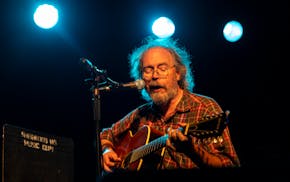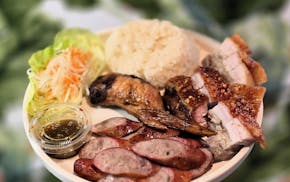St. Paul's Newell Park was largely deserted on a recent cold and rainy Saturday, except in one corner, where a bunch of people were dodging behind oak trees, filling the air with flying foam darts and the constant "phut! phut! phut!" sound coming from the brightly colored plastic toys they were holding.
At first glance, it looked like kids playing with Nerf guns, except most of these people were grownups. And lots of them were carrying foam-dart devices that didn't come out of a Hasbro factory.
"We admit we're grown people playing with toys and there's nothing wrong with that," said Autumn Eule-Nashoba, a member of the Minnesota Nerf Community Facebook group, which has about 300 members.
Eule-Nashoba is one of a growing number of Minnesotans who take foam-dart shooting seriously, who spend hundreds of dollars on custom, high-tech, high-performance toys, who build up collections of 200, 300 even 500 "blasters" (they don't call them guns). In a quest to create devices that fling foam faster and farther, they even build their own blasters with 3-D printers and PVC tubing and test dart speeds with electronic chronograph devices.
Many are aiming to have a souped-up blaster capable of flinging a foam dart at least 200 feet per second, or nearly 140 miles per hour, about two or three times that of a typical store-bought Nerf blaster.
The hobby appeals to tinkerers who like to expand the limits of the devices with stronger springs, more powerful batteries and barrels lubricated with furniture polish.
"We're attempting to get more energy out of the system," Eule-Nashoba said.
It's also a hobby that attracts collectors who prowl through Goodwill and other thrift stores looking for cheap, secondhand Nerf blasters that could be fun to modify or might have value as a collectible.
That's how Matt Nelson of Otsego, Minn., amassed more than 500 blasters, ranging from the first ones sold by Nerf in 1989 to a no-longer-available lithium-polymer battery-powered, rapid-fire blaster worth up to $600 made by a company called Project FDL.
Luke Goodman, who is originally from Rochester, Minn., said he gave up his previous career as a filmmaker in the San Francisco Bay Area after his sideline of designing and making blaster modifications took off.
Now he has a company based in Vancouver, Wash,, called Out of Darts with eight employees and nearly 100 3-D printers cranking out high performance blaster parts, DIY kits and an upcoming "bespoke, high-end blaster" that will cost $700.
"The hobby has grown so much," Nelson said. "It's kind of like fishing. Everybody has way too much equipment."
And every month or so, the Twin Cities blaster community gets together in a local park to bounce foam darts off each other while playing informal capture-the-flag style games.
"It's a glorified game of tag," said Dan Beaver, a Columbia Heights resident who helps to organize the blaster gatherings.
The higher performing blasters make outdoor gatherings possible because they are powerful enough to send a foam dart flying across a field, not just a living room.
The activity can resemble paintball, airsoft or laser tag, with some important differences. Foam-dart fans say their hobby is more accessible to DIYers. It's cheaper than other shooting games. Events are typically free and foam darts are cheap and resuable. Getting hit with a foam dart hurts less and is less intimidating than a paint ball. And it's more approachable to people of different ages and abilities.
Goodman said playing with blasters tends to be more lighthearted and whimsical compared to other shooting games.
"The culture is pretty different," said Cole Miska, a Minneapolis fan. "We're there to have fun."
"Anybody can play with these Nerf blasters," said Nelson, who co-founded a nonprofit called Project My Neighborhood that sponsors blaster events as a platform for bullying prevention.
Unlike many paintball or airsoft shooters, foam-dart shooters aren't built to resemble real guns. They're typically made of neon colored plastic. The Minnesota Nerf group also avoids dressing or acting like military cosplayers. They avoid using the "g-word."
"We very deliberately avoid anything that looks like a real firearm," Eule-Nashoba said.
"This is not playing with guns, This is Nerf," Miska said.
The nonthreatening nature of foam-dart blasters means "we can play in public spaces," Eule-Nashoba said.
As long as everyone wears eye protection and picks up the darts after the shooting is done, "you can pop that up anywhere," Nelson said.
About 15 people showed up at the recent gathering at Newell Park, but they brought enough gear to cover several picnic tables with blasters along with plastic bins filled with hundreds of foam darts.
There were home-built blasters, blasters bought from thrift stores and blasters made by Dart Zone, a high-performance brand that competes with Nerf.
Aaron Schoolmeesters of Coon Rapids brought his 3-D-printed Caliburn blaster that he named "Lyulf," an old English word meaning "fire wolf."
The Caliburn, which Schoolmeesters says can fire darts at 250 feet per second, was designed by a legendary freelance blaster engineer who goes by Captain Slug and makes his designs available as open source files.
"I talk about it at work and people kind of snicker," said Dan Cotton, an enthusiast from Paynesville, Minn. He admits that "there's only one letter difference between nerd and Nerf."
But he said building and modifying foam dart blasters can be both an artistic and engineering challenge.
"It's a very in-depth and immersive hobby," he said.

Critics' picks: The 11 best things to hear, do and see in the Twin Cities this week

Critics' picks: The 9 best things to do and see in the Twin Cities this week

The 5 best things our food writers ate this week

The 5 best things our food writers ate this week









